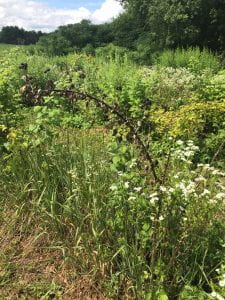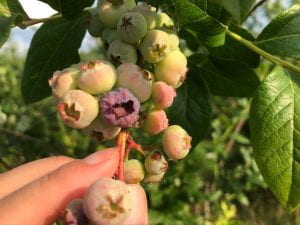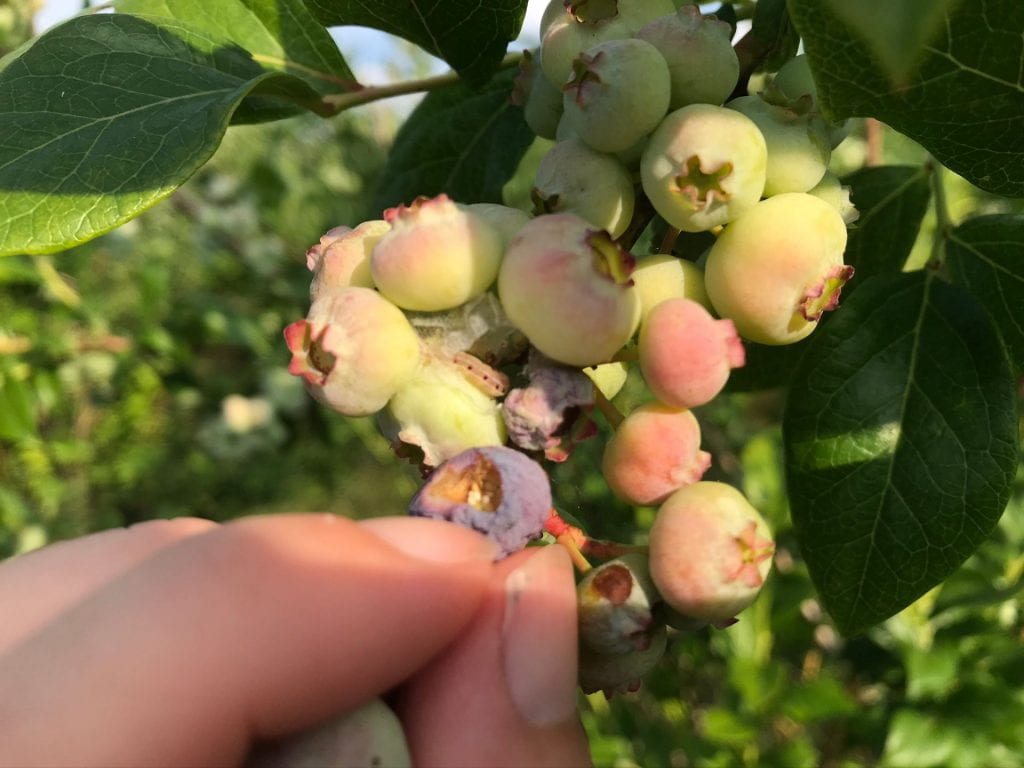
Crop Stages: We are in peak Rubus (raspberry, blackberry) season, with all but the latest strawberry varieties finished. See last week’s post for strawberry renovation recommendations. Blueberries are coming on strong, with early to mid-season varieties ripening, depending on micro-climate. In WNY, the lake districts have been earlier than the Southern Tier. U-pick interest continues to be strong, and growers are showing great creativity in managing visitors and social distancing.
Raspberry/Blackberry concerns:
- Phytophthora root rot is showing up in many plantings as plants are

This black raspberry floricane was likely killed by phytophthora root rot. stressed with the ripening crop load. The leaves will start to die from the margins, then the entire cane will wilt and blacken. This can sometimes be confused with cane or crown borer, but will most likely show up as a whole field issue, or just in wet patches.
- Japanese beetles are doing a lot of damage to leaves and fruit. They can be managed with common insecticides, but are good fliers and new ones will show up within a few days.
- While we are all grateful for the recent rains, this increases the likelihood of fruit rots. Pick promptly after rain, removing any damaged/moldy berries, and consider a short PHI fungicide to protect ripening berries.
- SWD is still (always) a worry with brambles – try to stay on at least a weekly insecticide rotation throughout harvest. Remove all ripe and over-ripe berries from the field on as tight of a harvest schedule as you can manage, to reduce in-field population growth.
Blueberry concerns:

- Mummyberry infections are showing up in many fields, the severity may be due to the late frosts, which increase susceptibility to infection. There is little to be done at this time – the berries are already infected, even if it doesn’t show until they start to ripen. However, you should not forget about the issue! Note the areas/varieties affected, to address next spring with sprays, or to use cultural controls, like raking, mulching, or urea applications to disrupt the infection cycle. Read this classic fact sheet for more information, or a quick online search will provide many more resources.
- Cherry and cranberry fruit worms are out there too. Their presence will accelerate the ripening/senescence of berries, making the affected fruit easy to spot in a variety that is just about to turn blue. They may also make the berries shrivel, which can be confused with mummyberry.

This berry could easily be diagnosed as having mummyberry… - Anthracnose fruit rot is starting to appear in some plantings. It is now too late to prevent this disease, but again, make a note to take aggressive actions next spring to avoid this disease building up again.
- SWD…just keep spraying, just keep spraying. Also, don’t forget that SWD loves shady, protected areas. If you can find the time, clearing weeds in the rows and around the plants, and keeping rows mowed will reduce their preferred habitat. Prompt harvest and good field sanitation can help reduce in-field population growth. Promptly chilling berries and maintaining the cold chain will extend the shelf life and prevent post-harvest development of the pest (better a small larvae than a large one!).

